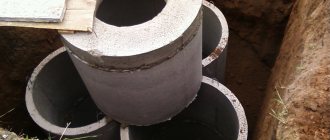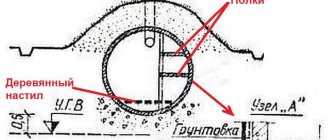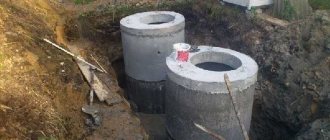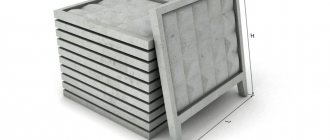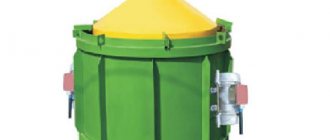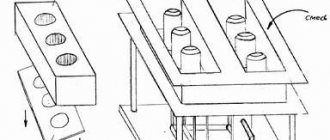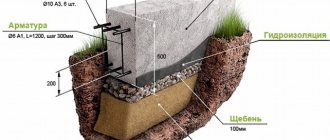Sealed cesspool made of concrete rings
A cesspool made of concrete rings with a sealed cesspool function is an absolute plus for the soil and for the plants that grow nearby. But by making a sealed cesspool, you directly depend on the arrival of a sewage disposal machine, which pumps out liquid from your cesspool once a month. Of course, if your family consists of only a few people and in winter or summer you do not use a dacha or country house, then it is quite appropriate to build a sealed cesspool since the fee for cesspool cleaning services is kept to a minimum and calls to them are made very rarely .
And of course, one of the most important advantages of a sealed cesspool is clean water from the well, which is located on your site. Because a leaky cesspool is the main source of infection, which is carried in groundwater from the cesspool and can get into your well. Of course, seasoned builders will say that if you build a cesspool 15-20 meters from the well, then your water will not be afraid of pollution, but practice shows that this information is not always reliable, and besides, there are also neighbors who also have cesspools , and analyzing groundwater deposits and circulation is a very difficult task.
To summarize, if you have a small family and you don’t get out into nature very often, then a sealed pit made of concrete rings is the choice you need.
This is necessary to know before construction
Before making a cesspool from concrete rings or other materials, you should find out the positive and negative aspects of the design and its features. In general terms, this is a reservoir where sewage from the house goes. It may or may not have a bottom. In the second case, a sand and gravel bed is constructed and the wastewater is filtered through it into the soil.
Important! It is prohibited to create a cesspool with a filter bottom if the site has a high groundwater level (GWL), since there is a risk of toxic waste entering drinking water sources.
Positive traits:
- Affordable cost of arrangement.
- Durability. Subject to compliance with installation standards, the period of use is one hundred years.
- Easy to use.
Negative sides:
- Regularly call the vacuum cleaners if the pit is sealed.
- It is difficult to get rid of the smell in the area and keep it under control.
- It is necessary to create a convenient access to the cesspool; the hose of the vacuum trucks has a limited length.
- The risk of groundwater and soil contamination is such that it becomes unsuitable for growing vegetable and fruit crops.
Previously, when the cesspool was full, they simply filled it up and dug a new one. Now, due to the presence of a large number of biological and chemical substances, it becomes possible to regularly process sewage and reduce its volume. In liquid form, they seep into the soil. It is not necessary to clean solid sediments often - once every 2-3 years. A similar cesspool without pumping is also called eternal.
Rules for arranging a cesspool
- The cesspool should be located 15-20 meters from the well.
- About 10 meters from the country house.
- 4 meters from the fence.
- The depth of the cesspool should be no more than 5 meters.
So, after the hole of the required depth for us is ready, the time comes to install concrete rings. If you are not familiar with how to dig a hole, we advise you to take a look at this article. After the concrete rings have been lowered, the moment comes when it is necessary to hermetically insulate the base of the well and the joints between the rings directly. The insulation process can be done using concrete or using resinous mixtures, which you can either prepare yourself; for this you need to melt asbestos (over a fire) in a bucket and pour it into the seams between the rings, but pouring it will be extremely inconvenient without a special pump, so we still recommend using cement.
It is best to dig a hole about 3 meters deep, as this will allow the contents to be completely pumped out using a sewage disposal machine.
Next, you need to cover the bottom of the pit with reinforced concrete slabs to ensure safe access for this very machine to pump out waste.
Scheme of a pit made of concrete rings
Types of cesspool septic tanks made of reinforced concrete rings
The good thing about using reinforced concrete or concrete rings for a cesspool is that the need for cleaning occurs much less frequently than when using conventional storage tanks.
All types of sewer tanks of this type can be divided into several main types.
- Do-it-yourself drainage hole in a private house with a closed bottom. Models with a bottom do not actually carry out any wastewater treatment and serve only as storage tanks for subsequent pumping using a sewer truck.
- Overflow structures are, in fact, two-chamber septic tanks, in which sedimentation of solid particles in the first reservoir and soil filtration in the second, and most often, aerobic decomposition of impurities by microorganisms, take place. According to reviews, the installation of a cesspool in a private house of this type is significantly superior to the design described below in terms of the quality of wastewater treatment.
- A single-chamber model without a bottom is a kind of transitional option between a conventional storage tank and a septic tank. The cheap and simple construction of a cesspool made of concrete rings at the same time ensures partial treatment of wastewater and its drainage into the ground, due to which the filling of the tank occurs much more slowly, and the services of vacuum cleaners and their costs are required much less frequently.
At the same time, there are some restrictions in terms of the possibility of installing such a treatment plant. Water will flow freely through the filter into the ground only if the soil on the site is sandy, loose, and has good moisture permeability. Clay or loam may allow drainage to pass through at first, but will soon become an almost airtight barrier.
Another condition is a low level of groundwater. It is believed that groundwater should lie no closer than 50-100 cm from the bottom of the ring for the drainage pit in order to avoid mixing it with contaminated wastewater and the spread of harmful substances
Important! Installation of a cesspool made of concrete rings without a bottom is possible only if the volume of daily waste does not exceed 1 m³.
In pits without a bottom and in two-chamber models, you can use special biological products that promote the decomposition of organic impurities. This will help reduce the rate at which the tanks fill.
Cesspool with drainage system
A cesspool with a drainage system used to be very popular, partly due to the fact that not every house had a sewer system and simply the water resources that the family used during the year managed to go into the ground and simply be disposed of naturally by mixing with groundwater. But the consumption of water resources is growing, and with it human needs are growing, which is why a cesspool with a drainage system simply cannot cope with the large amount of waste accumulated over the course of a year, or even several months.
But it is worth noting that a cesspool can be made with a drainage system by pouring bulk materials into its bottom, and not filled with concrete. Then some of the water will go into the ground, and provided that the hole is filled, it will be possible to call a sewer truck. As a result, it will be cheaper to collect and pump out water, since less water will have to be pumped out.
But please note that this will contaminate groundwater and may create an unpleasant odor around the house.
As for the construction of this structure, the work essentially remains the same, the only thing that really changes is the pillow that we will make, at the bottom it consists of:
- Layer of sand.
- A layer of crushed stone.
- And coverings made of thermally bonded geotextiles.
The process of installing concrete rings in a cesspool
Cesspool made of other materials
In addition to the most common version of a cesspool made of concrete rings, there are many analogues. Some of them are cheaper, but are not suitable for use in homes with permanent residence, some are more expensive, but have restrictions on use in certain types of soil.
Brick cesspool
You don't have to be a mason to lay brick walls on a well. It is enough to have minimal knowledge and acquire basic skills in bricklaying. To complete the work you will need:
- an ordinary bayonet shovel - for leveling the soil in the right places;
- shovel - for collecting and removing excess earth;
- ladder - in order to go down and get out of the pit;
- tape measure - to measure the required dimensions;
- buckets - for carrying solution and various materials;
- trowel - to apply the mortar to the masonry;
- level - allows you to control the strict verticality of the walls.
The materials you will need are brick, cement, sand and water.
If you are laying a hole with a sealed bottom, then first you need to prepare a concrete base. To do this, you need to make a compacted sand cushion with a thickness of at least 20 cm. After installing the cushion, you can begin pouring concrete. The thickness of the concrete bottom should be at least 5-7 cm; it is also possible to reinforce such a base to give it greater rigidity.
After the concrete has hardened, the construction of the masonry can begin. At the same time, there are no special requirements either for the quality of the brick or for the quality of the masonry itself; the main thing is compliance with the level and the absence of cracks in the masonry. The pit can be either square or round - it all depends on your imagination.
If you are building a sewer without a bottom, then you need to make a cushion under the brick and pour concrete in the shape of a ring so that water can flow into the inside.
Tire cesspool
A cesspool made from unnecessary car tires is distinguished by its low cost and ease of assembly. To install such a pit, you will need old tires of the required diameter; for a small volume, tires from a passenger car are suitable, and for a large volume, you can take them from a truck or even a tractor.
To add usable space, the side parts of the tires must be cut in a circle. This can be easily done with a jigsaw or grinder. But if they are not available, a regular, only very sharp, knife with a rigid blade will do.
The prepared tires are laid one on top of the other in a pit dug in advance to match the diameter of the workpieces and fastened together with plastic ties, bolts and nuts, etc. If necessary, the joints between tires can be sealed with bitumen or other adhesive.
This type of cesspool is often used to collect wastewater in a bathhouse or summer kitchen.
Plastic cesspool
The easiest way is to make a pit for drainage from a ready-made plastic container, which you can buy in the store. You just need to dig a pit and install the container itself there.
The indisputable advantages of this method are that you will deprive yourself of the unpleasant odor and be one hundred percent sure that the wastewater will not get into the soil and will not mix with groundwater. But as it fills, you will have to call a sewer truck to pump it out, which will undoubtedly entail a waste of money.
Also, restrictions for such containers are imposed by the groundwater level, since if their level is high, the container can be squeezed out of the ground.
How to clean a cesspool
You can pump out the contents of a cesspool by inviting specialists with equipment that should be no less in volume than the volume of your cesspool. The hose of such a sewer truck should be sufficient until it is completely lowered into the pit, and access to the pit should be convenient.
There are also special products for cleaning cesspools, which are completely harmless bacteria that process waste. You can buy such products at any home and garden store. Such products perfectly clean even the walls and bottom of the pit, processing solid waste into sludge, gas and water.
Thus, a cesspool in a private house is an economical option for organizing sewerage, requiring attention only a few times a year. The undeniable advantage of a cesspool made of concrete rings is its durability, low cost and the ability to install such a system with your own hands using minimal equipment.
Did the article help? Rate her
Construction work of a cesspool
We dig a hole in which we will install the rings. Its diameter should be 0.4 m larger than the rings, and its depth should be 0.2 m larger. Based on many recommendations, photos, videos, we will draw a diagram for the simplest installation of this type of sump. So, next we perform the following steps:
- We level and compact the bottom;
- We make a sand cushion;
- Next, install the lower ring with the bottom or make the bottom with your own hands;
Attention! The first option takes much less effort and time, so experts recommend it.
- If you have chosen the second development option, then the first thing we do is purchase materials;
- We place a grate in the sewerage drainage hole, the dimensions of which are adjusted to the volume of the pit;
- We tie the reinforcement bars with wire;
- Prepare concrete solution;
- We fill the bottom of the sewer pit, evenly distributing concrete over the entire area.
Attention! It is imperative to bayonet the solution to reduce the size of air bubbles.
Place for a ring pit
Properly positioning a ring device is not as easy as it may seem. Therefore, after studying a schematic photo based on the SNIP set of Building Codes and Rules, we will describe to you the basic rules. So, the most important thing is that the distance from the pit to the house should be more than 5 meters, and the well should have a distance of more than 30 meters from it.
Construction should not take place at the lowest point of the site or in a ravine. This is explained by the fact that there is a high probability of flooding of the pit during precipitation. But the worst thing is that this situation can lead to contamination of the soil of the site. Remember that the pipeline and sewerage drainage system must be placed on a slope to ensure gravity flow of water.
Attention! Installation of a sewer drain requires a slope of 3 degrees or 3 centimeters for each meter of pipe.
The last important condition for proper installation is to provide access for sewage disposal equipment for pumping. From all of the above, it follows that choosing a location is a rather responsible and time-consuming process.
How to make a septic tank from concrete rings with your own hands?
